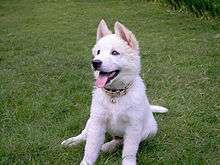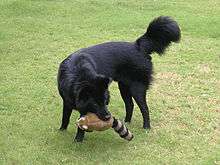Kintamani (dog)
 3-month old white puppy with apricot-tipped ears | |||||||||||||||||||||||||||||
| Other names | Balinese Kintamani, Balinese Mountain Dog, Balinese Dog, Bali-Berghund | ||||||||||||||||||||||||||||
|---|---|---|---|---|---|---|---|---|---|---|---|---|---|---|---|---|---|---|---|---|---|---|---|---|---|---|---|---|---|
| Common nicknames | Kinta | ||||||||||||||||||||||||||||
| Origin | Indonesia | ||||||||||||||||||||||||||||
| Breed status | Not recognized as a standardized breed by any major kennel club. | ||||||||||||||||||||||||||||
| |||||||||||||||||||||||||||||
| |||||||||||||||||||||||||||||
| Notes | Recognized by the Perkumpulan Kinologi Indonesia (Indonesian Kennel Club) and Asian Kennel Union | ||||||||||||||||||||||||||||
| Domestic dog (Canis lupus familiaris) | |||||||||||||||||||||||||||||
The Kintamani is a dog native to the Indonesian island of Bali. It is a popular pet for the Balinese and locally Bali's only official breed and efforts are currently under way to have the dog accepted by the Federation Cynologique Internationale as a recognized breed. It is an evolving breed indigenous to the Kintamani region which evolved from the local Bali street dogs, which are rather a feral random-bred landrace distinctive to Bali.
Genetic evidence
Genetic studies have shown that, despite evidence to the contrary, the Kintamani dog is native to Bali. Thirty-one highly polymorphic short tandem repeat markers from Kintamani dogs, Bali street dogs, Australian dingoes, and nine American Kennel Club (AKC) recognized breeds of northeast Asian or European origin were compared. The Kintamani dog was identical to the Bali street dog at all but three loci. The Bali street dog and Kintamani dog were most closely aligned with the Australian dingo, more distantly related to AKC recognized breeds of Chinese origin, and most distantly related to AKC breeds from western Eurasia. Therefore, the Kintamani dog has evolved from Balinese feral dogs with little loss of genetic diversity.[1]
Characteristics
These results come despite observable facts about the Kintamani Dog that make them more similar to breeds from elsewhere and which set them apart from the average village dog; facts which had lent credence to a local folk belief that the breed originated 600 years ago from a Chinese Chow Chow brought from abroad.
The Kintamani looks something like a mix between the Samoyed and a Malamute. They have long hair, a broad face, a flat forehead, and flat cheeks like Chinese dogs such as the Chow Chow and are amenable to life as a pet. Whilst many live much the same kind of life as an average village dog, they dig holes to nest their young and some live in small caves among the boulders around Kintamani. They are locally considered good-looking dogs are more often sought after as good pets. The Kintamani dog is gentle around people, yet retains enough assertive behavior to render it a noteworthy (but not vicious) watchdog.[1]

The most desired and only officially accepted coat color is white - preferably with apricot-tipped ears. Breeders often confine the dogs to cold dark caves near the Kintamani volcano, insisting it an essential step in developing the thick white coat. However, other coat colors, such as black, beige, and brindle exist.
The withers height of the female Kintamani dog is 40–50 cm, 45–55 cm for the male, about the same as the stature of the Bali street dog. The desired physical traits of the Kintamani dog include erect ears, forwardly curved tail held at the midline, medium to longhaired coat, almond-shaped brown eyes, and black skin pigment.
Bali street dogs come in many colors and coat patterns, and they are almost always shorthaired and straight- to curve- tailed. Both still whelp in burrows dug into the earth, a feral dog trait.
Temperament
A fiercely independent breed, Kintamanis can be aggressively territorial while at the same time tender and affectionate with their own families. While most dog breeds are disinclined to climbing and heights, Kintamanis will climb across roofs and spend parts of the day happily installed sitting or sleeping atop a garden wall. They are light-footed and move freely, smoothly and lithely, and will bark when confronted with an unfamiliar sound or sight.
History
Genetic studies of the breed have shown that has probably evolved from local Balinese feral dogs, and is distantly related to other Asian breeds.[1]
It is also possible that the Kintamani Dog came with the Javanese invaders from the kingdom of Majapahit in 1343 or with the Javanese refugees of the civil war in the 15th century. But of all the hypotheses, about the origins of the Kintamani Dog, only one is really plausible: that sometime between the 12th and the 16th century a Chinese trader named Lee landed in Singaraja in Northern Bali, bringing with him a Chow Chow dog which bred with the local Balinese feral dogs. Lee later in settled in the Kintamani region and raised his family there. Evidence that the Lee family lived in Kintamani exists in the form of a Chinese temple in which people of the Confucian faith still worship.
Accreditation
In order to get international accreditation for the breed the Bangli Regency authority facilitates the Kintamani Dog Exhibition and Contest every year to promote the Kintamani Dog. The authority also guides Kintamani Dog breeders, makes rules about Kintamani Dog purification areas and has made a demonstration pilot project in some villages.[2]
See also
References
- 1 2 3 Puja IK, Irion DN, Schaffer AL, Pedersen NC (2005). "The Kintamani dog: genetic profile of an emerging breed from Bali, Indonesia". J. Hered. 96 (7): 854–9. doi:10.1093/jhered/esi067. PMID 16014810.
- ↑ "Kontes Anjing Kintamani di Bangli Layak Dapat Penghargaan Dunia". June 16, 2014.